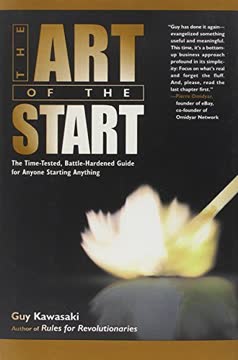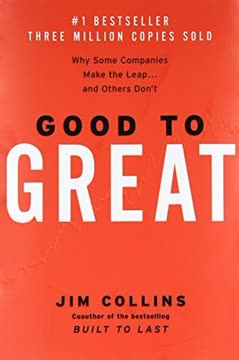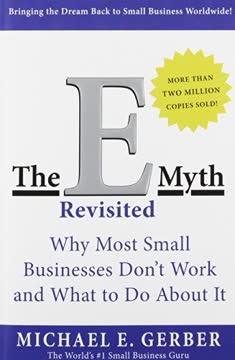Key Takeaways
1. The American Century: Rise of U.S. Business Titans
"America has produced people able to do all these things (just as these nations have all produced businesspeople); but, speaking generally, America as a nation and a culture has not distinguished itself as the best in any of them. Isolated instances of excellence spring up in a variety of endeavors all over the world, sometimes in pretty unexpected places. When one takes the long view, however—say, 250 years—it is fair to assert that America has been the best in starting and nurturing companies."
Unparalleled entrepreneurship. The United States emerged as the global leader in business innovation and entrepreneurship during the late 19th and 20th centuries. This period saw the rise of iconic American companies and business leaders who transformed industries and shaped the modern economy.
Factors for success. Several factors contributed to America's business dominance:
- A culture that encouraged risk-taking and innovation
- Abundant natural resources and a large domestic market
- A relatively open and mobile society that allowed talent to rise
- A legal and financial system that supported business growth
The book profiles seven business titans who exemplify this era of American entrepreneurial success, each leaving an indelible mark on their respective industries and the broader economic landscape.
2. Andrew Carnegie: From Rags to Riches in the Steel Industry
"Carnegie was undiscouraged by the fate of the Detroit Automobile Company and the Henry Ford Company. The modern Ford Motor Company was incorporated on June 16, 1903, a month and a half prior to Henry Ford's fortieth birthday. A decade later, he was the undisputed leader of the industry, possessor of a fortune beyond calculation, and well on his way to world fame."
Immigrant success story. Andrew Carnegie's journey from poor Scottish immigrant to steel tycoon epitomizes the American dream. His rise demonstrates the opportunities available in 19th-century America for those with ambition and business acumen.
Steel industry transformation. Carnegie revolutionized the steel industry through:
- Vertical integration, controlling all aspects of production
- Continuous technological innovation
- Ruthless cost-cutting and efficiency measures
- Strategic acquisitions of competitors
Carnegie's later life was marked by extensive philanthropy, establishing libraries and educational institutions across America. His story highlights both the immense wealth creation possible in this era and the ethical dilemmas faced by industrial magnates.
3. George Eastman: Revolutionizing Photography for the Masses
"You press the button and we do the rest."
Democratizing photography. George Eastman transformed photography from a complex, professional endeavor to an accessible hobby for the masses. His innovations made Kodak a household name and photography an integral part of American culture.
Key developments:
- Invention of roll film, replacing cumbersome glass plates
- Introduction of the Kodak camera, pre-loaded with film
- Development of a comprehensive system for film processing and printing
- Creation of the "Kodak moment" concept in advertising
Eastman's business acumen extended beyond technical innovation. He pioneered modern marketing techniques and built a global brand. His story illustrates how technological innovation combined with smart marketing can create entirely new markets and consumer behaviors.
4. Henry Ford: Pioneering Mass Production and the Automobile Industry
"I will build a car for the great multitude, constructed of the best materials by the best men to be hired after the simplest designs that modern engineering can devise...so low in price that no man making a good salary will be unable to own one—and enjoy with his family the blessing of hours of pleasure in God's great open spaces."
Revolutionizing manufacturing. Henry Ford's implementation of the moving assembly line and standardized parts revolutionized manufacturing, not just for automobiles but for industry in general. This innovation dramatically reduced production costs, allowing for lower prices and higher wages.
Ford's impact:
- Introduction of the Model T, the first affordable automobile for the middle class
- Implementation of the $5 workday, doubling the prevailing wage
- Development of a vast, vertically integrated production system
- Creation of a new consumer culture centered around the automobile
Ford's story also illustrates the potential pitfalls of success, as his later years were marked by inflexibility and resistance to change, nearly costing him his company.
5. Thomas J. Watson Sr.: Building IBM and Transforming Business Machines
"THINK"
Building a technology giant. Thomas J. Watson Sr. transformed a small business machine company into the global powerhouse that became IBM. His leadership style and business practices shaped corporate America for decades.
Watson's key strategies:
- Focus on sales and customer service
- Heavy investment in research and development
- Creation of a strong corporate culture
- Emphasis on employee loyalty and development
Watson's tenure at IBM showcases the importance of adapting to technological change and building a strong organizational culture. His famous "THINK" slogan encapsulated his philosophy of constant innovation and improvement.
6. Charles Revson: Reshaping the Cosmetics Industry with Revlon
"In the factory we make cosmetics; in the drugstore we sell hope."
Marketing innovation. Charles Revson transformed the cosmetics industry through innovative marketing and product development. He understood that cosmetics were about more than just the product—they were about selling an image and a lifestyle.
Revson's strategies:
- Frequent introduction of new colors and product lines
- Use of high-profile advertising campaigns
- Leveraging television for product promotion
- Creating a luxury brand image at accessible price points
Revson's story highlights the power of branding and marketing in creating consumer desire, as well as the potential dark side of a driven, perfectionist leadership style.
7. Sam Walton: Revolutionizing Retail with Wal-Mart
"There is only one boss. The customer. And he can fire everybody in the company from the chairman on down, simply by spending his money somewhere else."
Retail revolution. Sam Walton transformed American retail by creating a new model of discount stores focused on low prices, wide selection, and excellent customer service. Wal-Mart's success challenged traditional retail practices and reshaped the American consumer landscape.
Walton's key innovations:
- Sophisticated logistics and inventory management systems
- Aggressive expansion into rural and small-town markets
- Cultivation of a strong corporate culture
- Early adoption of computer technology for supply chain management
Walton's success demonstrates the power of focusing relentlessly on customer needs and continuously innovating in business operations.
8. The Derangement of Power: The Price of Success for Business Titans
"Power does more than corrupt. It does something more subtle and insidious. The word I choose to describe the impact of power is that it 'deranges.'"
Pitfalls of success. Many of the business titans profiled experienced a "derangement of power" as their wealth and influence grew. This often led to personal eccentricities, ethical lapses, or an inability to adapt to changing circumstances.
Common manifestations:
- Increasing isolation from dissenting views
- Belief in one's own infallibility
- Difficulty in personal relationships
- Resistance to change or new ideas
This phenomenon underscores the importance of maintaining perspective and ethical grounding as one achieves success, and the potential dangers of unchecked power in business leadership.
9. Television's Impact: Transforming Advertising and Consumer Culture
"For all the impact that Fire and Ice undoubtedly had in the trade, for the contribution it made toward establishing Revlon as an industry leader, and for all the money it made for the company, it is hard to make the case looking at the numbers in Table 5.1 that it changed the world. Looking at the numbers following the embrace of television, it is easy to make that case. Fire and Ice was 'normal science'; The $64,000 Question was a new 'paradigm.'"
Media revolution. The advent of television in the 1950s dramatically transformed advertising and consumer culture. It provided a new, powerful medium for reaching consumers and shaping public opinion.
Television's impact on business:
- Creation of national advertising campaigns with unprecedented reach
- Rise of the celebrity spokesperson and product endorsements
- Development of new forms of entertainment tied to product promotion
- Acceleration of consumer trends and fashion cycles
The story of Revlon's success with "The $64,000 Question" illustrates how businesses that quickly adapted to this new medium could achieve dramatic growth and market dominance.
10. Innovation and Adaptation: Keys to Long-term Business Success
"Capitalists, as we mentioned in the introduction, are 'people who make bets on the future.'"
Continuous reinvention. The most successful businesses and leaders consistently demonstrated an ability to innovate and adapt to changing market conditions and technologies. This trait was crucial for long-term success and avoiding the fate of once-dominant companies that failed to evolve.
Key aspects of successful innovation:
- Investment in research and development
- Willingness to cannibalize existing product lines
- Openness to new ideas and technologies
- Ability to anticipate and shape consumer needs
The contrasting fates of companies like Kodak (which struggled to adapt to digital photography) and IBM (which successfully transitioned from hardware to services) illustrate the critical importance of this ability to innovate and adapt.
11. The Challenge to American Economic Dominance in the Late 20th Century
"By the 1970s, the picture had changed completely. Efficient and appealing Japanese automobiles returned to the United States, and with a vengeance."
Shifting global landscape. The late 20th century saw challenges to American economic dominance, particularly from Japan and later other Asian economies. This shift forced American businesses to reevaluate their strategies and practices.
Factors contributing to the challenge:
- Rise of Japanese manufacturing efficiency and quality control
- Increasing globalization of supply chains and markets
- Technological advancements leveling the playing field
- Complacency and resistance to change in some American industries
This period of challenge ultimately led to renewed innovation and adaptation in American business, setting the stage for new areas of economic leadership in technology and services in the 21st century.
Last updated:
FAQ
What's Giants of Enterprise about?
- Focus on Innovators: Giants of Enterprise by Richard S. Tedlow examines the lives and careers of seven influential American business leaders who transformed their industries.
- Historical Context: The book spans from the mid-19th to the late 20th century, illustrating the evolution of business practices and the American economy.
- Biographical Essays: It features detailed essays on Andrew Carnegie, George Eastman, Henry Ford, Thomas J. Watson Sr., Charles Revson, Sam Walton, and Robert Noyce.
Why should I read Giants of Enterprise?
- Inspiration from Success: The book offers inspiring stories of perseverance and innovation from seven business titans.
- Business Evolution Insights: It provides valuable insights into the evolution of American business, relevant for those interested in entrepreneurship or economic history.
- Leadership Lessons: Tedlow explores different leadership styles, offering practical lessons for current and aspiring business leaders.
What are the key takeaways of Giants of Enterprise?
- Individual Drive Matters: Personal qualities like ambition and resilience were crucial to the leaders' success.
- Role of Institutions: American institutions played a supportive role, encouraging innovation and risk-taking.
- Adaptability and Change: The book highlights the need for leaders to adapt to shifting market conditions over time.
Who are the seven business leaders featured in Giants of Enterprise?
- Andrew Carnegie: A steel magnate who became one of the richest men in history and a leading philanthropist.
- George Eastman: Founder of Kodak, he revolutionized photography by making it accessible to the masses.
- Henry Ford: Known for the Model T and the assembly line, he transformed the automotive industry.
What are the best quotes from Giants of Enterprise and what do they mean?
- “Man’s character is his fate.”: This quote emphasizes that personal qualities and decisions shape one's destiny.
- “The freedom to engage in entrepreneurial activity has been broad, but it has not been limitless.”: It highlights the balance between opportunity and regulation in American business.
- “In the factory, we make cosmetics; in the store, we sell hope.”: This Revson quote captures the essence of marketing in the cosmetics industry.
How did Andrew Carnegie build his empire in Giants of Enterprise?
- Strategic Investments: Carnegie capitalized on the growing demand for steel during America's industrialization.
- Innovative Management: He embraced new technologies and management techniques to produce steel efficiently.
- Philanthropy and Legacy: Carnegie's commitment to philanthropy established his legacy as a socially responsible leader.
What was Henry Ford's impact on the automobile industry according to Giants of Enterprise?
- Mass Production Revolution: Ford introduced the assembly line, reducing production time and costs.
- Model T's Popularity: The Model T became a symbol of American mobility, selling millions.
- Labor Practices: Ford's decision to pay higher wages aimed to create a loyal workforce and stimulate consumer spending.
How did Thomas J. Watson Sr. shape IBM in Giants of Enterprise?
- Salesmanship Focus: Watson emphasized sales and marketing, transforming IBM into a leader in information technology.
- Corporate Culture: He fostered a strong corporate culture centered around the slogan “THINK.”
- Global Expansion: Under Watson, IBM expanded internationally, becoming a dominant player in computing.
What marketing strategies did Charles Revson use at Revlon in Giants of Enterprise?
- Emotional Appeal: Revson sold hope and beauty, effectively communicating this through advertising.
- Innovative Branding: Campaigns like “Matching Lips and Fingertips” enhanced brand identity and loyalty.
- Television Advertising: Sponsoring shows like The $64,000 Question boosted Revlon's visibility and sales.
What role did Sam Walton play in the retail industry according to Giants of Enterprise?
- Pioneering Discount Retailing: Walton introduced discount retailing, making quality products affordable.
- Customer-Centric Approach: His focus on customer satisfaction and low prices became Wal-Mart's foundation.
- First-Mover Advantage: Opening stores in underserved areas allowed Wal-Mart to establish a strong market presence.
How did Robert Noyce contribute to the technology industry in Giants of Enterprise?
- Co-Inventor of the Integrated Circuit: Noyce's invention enabled the development of modern computers.
- Founding Intel: As a co-founder, he played a crucial role in advancing microprocessor technology.
- Encouraging Innovation: Noyce fostered a culture of innovation, allowing engineers to explore new ideas.
What lessons can modern entrepreneurs learn from Giants of Enterprise?
- Embrace Innovation: Staying ahead of industry trends is crucial for competitiveness.
- Understand Your Market: A deep understanding of customer needs is essential for success.
- Adapt and Overcome: Resilience and the ability to pivot strategies are crucial traits for entrepreneurs.
Review Summary
Giants of Enterprise receives mostly positive reviews, with an average rating of 4.19 out of 5. Readers appreciate the insightful profiles of seven influential American business leaders, highlighting their innovations and impact on industry. The book is praised for its honest portrayal of the subjects, including their flaws and mistakes. Some reviewers find the writing style uneven or overly detailed, while others consider it a fascinating read. Critics note that the book may not offer much new information for those already familiar with these historical figures.
Similar Books








Download PDF
Download EPUB
.epub digital book format is ideal for reading ebooks on phones, tablets, and e-readers.




